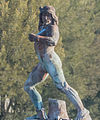art.wikisort.org - Artist
Manuel Vilar i Roca (15 November 1812, Barcelona - 25 November 1860, Mexico City) was a Spanish sculptor, in the Romantic style.[1]
Manuel Vilar | |
|---|---|
 | |
| Born | Manuel Vilar i Roca 15 November 1812 Mataró, Catalonia, Spain |
| Died | 25 November 1860 (aged 48) Mexico City, Mexico |
| Nationality | Spanish |
| Known for | Sculpture |
| Movement | Romanticism |
Biography
His first studies were at the Escola de la Llotja, with Damià Campeny. In 1833, with a grant from the Board of Commerce, he went to Rome where he studied with Antoni Solà and was an assistant in the workshops of Pietro Tenerani. He also received advice from Bertel Thorvaldsen and was influenced by the Nazarene movement.
Upon his return to Spain, he became an instructor at the Escola. He served in that position until 1845, when he and the painter Pelegrí Clavé received offers of employment in Mexico. There, he became the head of the sculpture classes at the Academia de San Carlos.[2]
During his tenure, he insisted on the rigorous study of anatomical models, the sketching of classical examples, practicing on blocks of marble, making plaster castings, and modelling with clay. He worked with religious and historical subjects, as well as the classics, which included themes from the Pre-Hispanic history of Mexico. Although his style owed much to Romanticism, he also introduced elements of Realism; giving his work an eclectic character.[1]
His early works, in Barcelona, focused on Biblical and mythological subjects; including Jason stealing the golden fleece and the trial of Daniel in Babylon.[2] His specifically Mexican subjects include Moctezuma, La Malinche, Iturbide and Tlahuicole, as well as numerous busts; notably Lucas Alamán and Antonio López de Santa Anna. He also created a statue of San Carlos Borromeo, which may be seen on the patio of the Academia.[1]
He died of pneumonia, aged only forty-eight, and was interred at the iglesia de Jesús Nazareno, where his students created a monument in his memory.[1]
Gallery
- Jason Stealing the Golden Fleece
- Monument to Tlahuicole
- Monument to Columbus
- A bust of Manuel Vilar,
by Felipe Sojo (1833-1869)
References
- Alberto Espinosa, La Renovación de la Real Academia de San Carlos: Manuel Vilar y Pelegrín Clavé, @ Terranova
- "Manuel Vilar". Gran Enciclopedia Catalana (in Catalan). Barcelona. .
Further reading
- Salvador Moreno, El escultor Manuel Vilar, Instituto de Investigaciones Estéticas, Universidad Nacional Autónoma de México, 1969
- José Rogelio Álvarez, "Vilar, Manuel", in: Enciclopedia de México, 2005 ISBN 978-1-56409-074-4
- "Vilar, Manuel", in: Diccionario Porrúa de historia, biografía y geografía de México, Vol.2, Editorial Porrúa, 1970
External links
- Works by Vilar @ the Reial Acadèmia Catalana de Belles Arts de Sant Jordi
На других языках
- [en] Manuel Vilar
[es] Manuel Vilar
Manuel Vilar i Roca (Barcelona, 15 de noviembre de 1812 - Ciudad de México, 25 de noviembre de 1860) fue un escultor romántico español.[1][2][fr] Manuel Vilar
Manuel Vilar i Roche (né à Barcelone le 15 novembre 1812 et mort le 25 novembre 1860 à Mexico) est un sculpteur romantique espagnol[1],[2].Другой контент может иметь иную лицензию. Перед использованием материалов сайта WikiSort.org внимательно изучите правила лицензирования конкретных элементов наполнения сайта.
WikiSort.org - проект по пересортировке и дополнению контента Википедии



